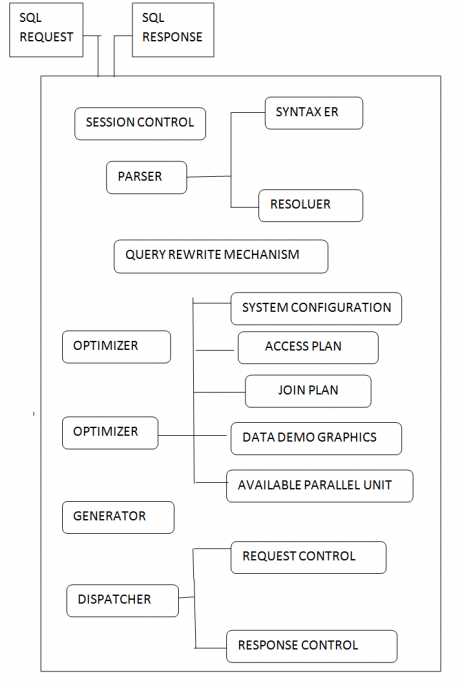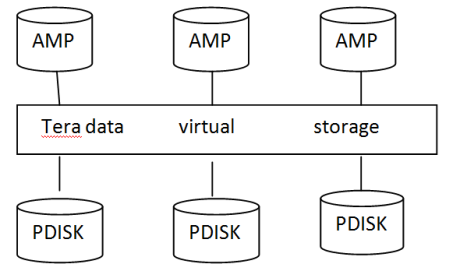Teradata Components

The following are the critical Teradata Components
PE BYNET AMP VSS 5.V DISK
AMP
AMP is vproc. vproc is nothing But a collection of instructions, which performs a specific operation(or)Task
PE[Passing Engine]

Passing Engine
It takes SQL Request and delivery SQL response
Session Control
- The session is nothing but a logical connection between user and Application.
- Passing Engine checks the authentication and authorization, if it’s valid, it does log in otherwise log off
Parser
- It checks syntactical Error
- It checks symmetrical Error
- It checks the Existence of an object
Inclined to build a profession as Teradata Developer? Then here is the blog post on, explore Teradata Training
Query Rewrite Mechanism
It writes the Query such away optimizer can understand easily
Example:
IF The Query is Q7, it converts into Q2
Optimizer
It is an important component in any database including Teradata It provides an execution plan for SQL Statement so that it is going to be executed by the database Generally it usages the below information.
- System configuration
- Available parallel unit
- Data Demographics, etc
- Access plan
- Join plan
Generator
It generated steps for the plan provided
Dispatched
It performs and manager request and response, flow control(Taking Request, Response keeping in Queue in delivery)
Note:
Passing Engine Handle max 120 sessions at a time
BYNET[BANYAN NETWORK]:
It acts as a” Message communication layer” between various components.
SMP BYNET [PE-AMP]
POINT - POINT-One message from PE To one AMP
MULTI CAST-One message from PE to Many AMPs
BROAD CAST- One message from PE to All AMPs
MPP BYNET[NODE-NODE]:
POINT- POINT-One message from One NODE to other NODE
MULTI CAST-One message from One NODE to Many NODE
BROAD CAST- One message from One NODE to All NODE
AMP[Access Module Processor]
1. Each AMP is responsible for managing a portion of MAIN DISK SPACE (VIRTUAL DISK)
2. This space not sharable by any other AMPs so we call architecture as shared-nothing architecture.
3. Each AMP Operator independently resources
4. Each AMP contains a database management subsystem. If perform the below operations.
- Performing DDL
- Performing DML
- Performing Joins
- Performing Applying and Releasing locks
- Performing Aggregate operation
- Performing OLAP operation
- Performing SORTING Operation etc.,
Note:
Max so task AMP TO perform at a time
Multiple AMP runs independently so high parallelism implement
VSS(Virtual Storage System):
- It is available from Teradata 13 onwards, basically, design to manage a multi-tier warehouse
- Teradata VSS Pools all of the cylinders within CLIQUE’s DISK SPACE and allocates cylinders from the storage pool.
- It migrates frequently used data (Hot data) to FASTER DEVICES and less frequently used data (cold data)to SLOWER DEVICES.
Before Teradata VSS
a) AMPS know the physical location of the cylinder which are address by DRIVE# (OR) CYLINDER#
b) Adjusting system AMPS integral number of drives per AMP
c) Adding storage requires an additional drive per AMP.
After TDV SS
a) AMPs don’t know the physical location of the cylinder and it can be changed, because of the cylinder in CLIQUE’s On effective in the pool, that are managed by Teradata virtual storage, virtual process.
b) Added drives are shared by all AMP’s
c) You can add several drives, This new Drive may have different capacity are performance than those drives, which are already present in the system
Before Teradata Virtual storage

After Teradata Virtual storage

Virtual Disk (or)VDISK

Collection of physical DISK (OR) Group of cylinder Arranged in Array position is called VDISK(or) virtual DISK Traditionally this called as DISK Array (or) Array of DISK After AMP performance operation, it invokes the controller this store and manages the data across physical disk This controller active array controller, the number of cylinders in an Array is called a RANK in the above Diagram the Rank is 3.(N-1)=4-1=3
- CLI-CALL LEVEL INTERFACE
- TDP-TERA DATA DIRECTORY PROGRAM
- MTDP-Micro Tera data Directory program
- MOSI- Micro Operating system Independent
- CA-Channel Application

For connection to the Teradata database system, we need to connect through either CHANNEL ATTACHED SYSTEM OR NETWORK ATTACHED SYSTEM
TDP(Teradata Directory Program)
- If check the authentication is successful, it creates a session and Logs on
- It balances multiple session [Create multiple session]
MTDP(Micro Tera data Directory Program)
It just like TDP cannot balances to sessions
CLI (CALL LEVEL Interface)
It is a low-level interface for request, response Blocking, and un- Blocking.
MOSI (Micro operating system Independent)
It checks the platform Independence of the operating system.
For In-depth knowledge on Teradata click on:
- BTEQ Features in Teradata
- Secondary Index in TeraData
- Memory Management in TeraData
- TPUMP Structure and Process In TeraData
- Multiple Cliques In System (OR) High Level In TeraData
You liked the article?
Like : 0
Vote for difficulty
Current difficulty (Avg): Medium
Recommended Courses
1/6
About Author

Name
TekSlate is the best online training provider in delivering world-class IT skills to individuals and corporates from all parts of the globe. We are proven experts in accumulating every need of an IT skills upgrade aspirant and have delivered excellent services. We aim to bring you all the essentials to learn and master new technologies in the market with our articles, blogs, and videos. Build your career success with us, enhancing most in-demand skills in the market.
Stay Updated
Get stories of change makers and innovators from the startup ecosystem in your inbox